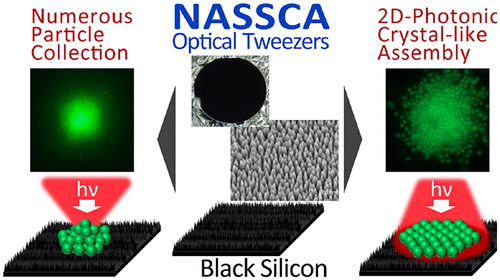当前位置:
X-MOL 学术
›
ACS Appl. Nano Mater.
›
论文详情
Our official English website, www.x-mol.net, welcomes your
feedback! (Note: you will need to create a separate account there.)
Optical Trapping of Polystyrene Nanoparticles on Black Silicon: Implications for Trapping and Studying Bacteria and Viruses
ACS Applied Nano Materials ( IF 5.3 ) Pub Date : 2020-09-14 , DOI: 10.1021/acsanm.0c01901 Sawa Komoto 1 , Tatsuya Nagai 1 , Ryota Takao 1 , Kenta Ushiro 1 , Mitsuhiro Matsumoto 1 , Tatsuya Shoji 1, 2 , Denver P. Linklater 3 , Saulius Juodkazis 4, 5 , Yasuyuki Tsuboi 1
ACS Applied Nano Materials ( IF 5.3 ) Pub Date : 2020-09-14 , DOI: 10.1021/acsanm.0c01901 Sawa Komoto 1 , Tatsuya Nagai 1 , Ryota Takao 1 , Kenta Ushiro 1 , Mitsuhiro Matsumoto 1 , Tatsuya Shoji 1, 2 , Denver P. Linklater 3 , Saulius Juodkazis 4, 5 , Yasuyuki Tsuboi 1
Affiliation

|
The optical trapping of polymer beads of different diameters d of 100, 200, 500, 1000, and 3000 nm on planar (F-Si) and nanostructured (BSi) crystalline silicon was investigated at laser wavelengths λ = 808 and 1064 nm, respectively. We demonstrate that BSi surfaces can enhance the optical gradient force required to grip nanoparticles (100 nm) in contrast to F-Si surfaces, significantly changing the trapping behavior. Thus, different modes of optical tweezing were characterized by modification of Si surface topography (nanostructuring), wavelength λ, laser irradiation intensity I, and irradiation area. Specifically, we present four separate modes of optical tweezing using planar and nanostructured Si for (i) a single particle trapped by tightly and loosely focused irradiation on F-Si, (ii) a large number of 3D assembled beads trapped by tightly focused irradiation on BSi, (iii) a small number of particles trapped on F-Si, and (iv) a large number of particles trapped on BSi, resulting in a 2D self-ordered assembly. The mechanisms of the optical manipulation of particles in the range 100–1000 nm were discussed with implications for the trapping of bacteria or viruses by using nanostructured semiconductor assisted optical tweezing (NASSCA/OT) and their response to high mechanical shear forces at locally changed temperatures on nanostructured surfaces.
中文翻译:

聚苯乙烯纳米粒子在黑硅上的光学诱捕:诱捕和研究细菌和病毒的意义。
研究了分别在λ= 808和1064 nm的激光波长下在平面(F-Si)和纳米结构(BSi)晶体硅上捕获的不同直径d为100、200、500、1000和3000 nm的聚合物珠的光阱。我们证明,与F-Si表面相比,BSi表面可以增强抓取纳米颗粒(100 nm)所需的光学梯度力,从而显着改变捕获行为。因此,通过改变硅表面形貌(纳米结构),波长λ,激光辐照强度I来表征不同的光镊模式。以及照射区域。具体而言,我们提出了使用平面和纳米结构Si进行光学钳制的四种单独模式,用于(i)通过在F-Si上紧紧和松散地聚焦照射而捕获的单个粒子,(ii)通过在其上紧紧聚焦的照射而捕获的大量3D组装珠子BSi,(iii)少量粒子被捕获在F-Si上,并且(iv)大量粒子被捕获在BSi上,从而导致二维自排序装配。讨论了在100-1000 nm范围内对粒子进行光学操作的机制,并通过使用纳米结构的半导体辅助光镊(NASSCA / OT)捕获细菌或病毒,以及它们在局部变化的温度下对高机械剪切力的响应在纳米结构表面上。
更新日期:2020-10-25
中文翻译:

聚苯乙烯纳米粒子在黑硅上的光学诱捕:诱捕和研究细菌和病毒的意义。
研究了分别在λ= 808和1064 nm的激光波长下在平面(F-Si)和纳米结构(BSi)晶体硅上捕获的不同直径d为100、200、500、1000和3000 nm的聚合物珠的光阱。我们证明,与F-Si表面相比,BSi表面可以增强抓取纳米颗粒(100 nm)所需的光学梯度力,从而显着改变捕获行为。因此,通过改变硅表面形貌(纳米结构),波长λ,激光辐照强度I来表征不同的光镊模式。以及照射区域。具体而言,我们提出了使用平面和纳米结构Si进行光学钳制的四种单独模式,用于(i)通过在F-Si上紧紧和松散地聚焦照射而捕获的单个粒子,(ii)通过在其上紧紧聚焦的照射而捕获的大量3D组装珠子BSi,(iii)少量粒子被捕获在F-Si上,并且(iv)大量粒子被捕获在BSi上,从而导致二维自排序装配。讨论了在100-1000 nm范围内对粒子进行光学操作的机制,并通过使用纳米结构的半导体辅助光镊(NASSCA / OT)捕获细菌或病毒,以及它们在局部变化的温度下对高机械剪切力的响应在纳米结构表面上。









































 京公网安备 11010802027423号
京公网安备 11010802027423号